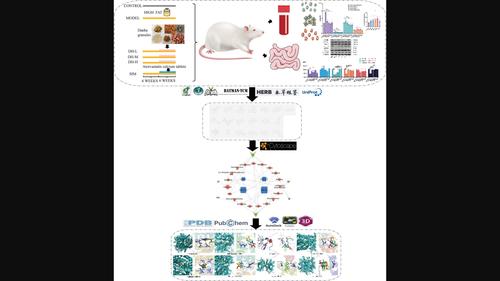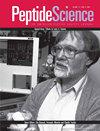Molecular mechanism study and potential active ingredients prediction of Danhe granules in the treatment of hypercholesterolemia via TICE
IF 1.7
4区 生物学
Q4 BIOCHEMISTRY & MOLECULAR BIOLOGY
引用次数: 0
Abstract
This study aims to explore the molecular mechanism and potential active ingredients of Danhe granules in improving the blood lipid level of hypercholesterolemia by intestinal TICE (transintestinal cholesterol excretion) through in vivo experimental research, network pharmacology methods, and molecular docking. The diet-induced hypercholesterolemia rat model evaluated the effects of Danhe granules on fecal cholesterol levels and intestinal TICE-related protein expression in rats. Based on the experimental results, the network pharmacology method was used to predict the potential active ingredients, and the binding strength between the potential active ingredients and key targets was further confirmed by molecular docking. Danhe granules increased LDLR, ABCG5, ABCB1, and LXRα which can promote the uptake of cholesterol by intestinal cells and the excretion of cholesterol into the intestine, and then reduce the levels of serum LDL-C and TC and increase the level of fecal TC, so as to achieve the effect of treating hypercholesterolemia. The results of network pharmacology and molecular docking showed that 19 active ingredients had good binding activity with the targets. These may be the active ingredients of Danhe granules for the treatment of hypercholesterolemia. This study revealed the molecular mechanism of Danhe granules in the treatment of hypercholesterolemia via TICE, and preliminarily clarified the potential effective ingredients. It provides new ideas for the treatment of hypercholesterolemia and the development of new drugs.

通过 TICE 对丹河颗粒治疗高胆固醇血症的分子机理研究和潜在活性成分预测
本研究旨在通过体内实验研究、网络药理学方法和分子对接,探讨丹鹤颗粒通过肠道TICE(经肠道胆固醇排泄)改善高胆固醇血症大鼠血脂水平的分子机制和潜在活性成分。饮食诱导的高胆固醇血症大鼠模型评估了丹鹤颗粒对大鼠粪便胆固醇水平和肠道TICE相关蛋白表达的影响。根据实验结果,采用网络药理学方法预测了潜在的活性成分,并通过分子对接进一步证实了潜在活性成分与关键靶点的结合强度。丹鹤颗粒能增加LDLR、ABCG5、ABCB1和LXRα,从而促进肠道细胞对胆固醇的摄取和胆固醇向肠道的排泄,进而降低血清LDL-C和TC水平,增加粪便TC水平,达到治疗高胆固醇血症的效果。网络药理学和分子对接结果表明,19 种有效成分与靶点具有良好的结合活性。这些可能就是丹鹤颗粒治疗高胆固醇血症的有效成分。该研究揭示了丹鹤颗粒通过TICE治疗高胆固醇血症的分子机制,初步明确了潜在的有效成分。它为治疗高胆固醇血症和开发新药提供了新思路。
本文章由计算机程序翻译,如有差异,请以英文原文为准。
求助全文
约1分钟内获得全文
求助全文
来源期刊

Peptide Science
Biochemistry, Genetics and Molecular Biology-Biophysics
CiteScore
5.20
自引率
4.20%
发文量
36
期刊介绍:
The aim of Peptide Science is to publish significant original research papers and up-to-date reviews covering the entire field of peptide research. Peptide Science provides a forum for papers exploring all aspects of peptide synthesis, materials, structure and bioactivity, including the use of peptides in exploring protein functions and protein-protein interactions. By incorporating both experimental and theoretical studies across the whole spectrum of peptide science, the journal serves the interdisciplinary biochemical, biomaterials, biophysical and biomedical research communities.
Peptide Science is the official journal of the American Peptide Society.
 求助内容:
求助内容: 应助结果提醒方式:
应助结果提醒方式:


